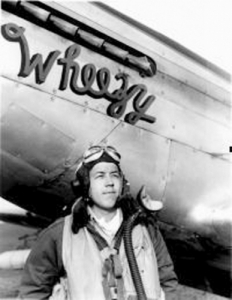Youngest gun
By Kenneth Fine
Published in News on August 4, 2013 1:50 AM

Submitted photo
Van Chandler, a member of the 4th Fighter Group, became the youngest American ace in World War II when, at 19 years old, he shot down his fifth German aircraft Jan. 1, 1945.
A 19-year-old American arrives at a Royal Air Force installation in England.
It's June, 6, 1944.
The historical significance of that particular day is not lost on 4th Fighter Wing historian Dr. Roy Heidicker.
"It's D-Day," he says. "So we're hitting the beaches and flying lots of missions out of Debden and he shows up."
Van Chandler did not climb into the cockpit of his P-51C that day.
But soon after he arrived at the home of the 4th Fighter Group, he took to the skies.
He had no idea that within a few months, he would be among the youngest men immortalized in aviation history books -- that after being shot down over enemy territory, he would find his way back to Debden and make a run at greatness.
He had no way of knowing that by mid-December, he would have two German kills to his credit -- that three more were on the horizon.
"On Christmas Day, 1944, he shoots down two more. That's four victories," Heidicker said. "And then, on New Year's Day, he gets his fifth. And remember, he's only 19."
In that moment, Chandler became the youngest American ace in World War II -- a feat that was never bested.
So when Heidicker learned that the pilot's widow, Mary, had donated her late husband's shadow box to Seymour Johnson Air Force Base, he took action.
"I said, 'Can we contact the family and see if someone from the family can come to the base and have a ceremony where they ... hand (the shadow box) to the wing commander?'" he said. "The response was, 'That would be fantastic.'"
And Monday, nearly 70 years after his historic flight, Chandler, in front of the men and women who make up the wing he helped define, will, at last, get his due.
*
Heidicker flips through a stack of black and white photos donated to the wing, by Mrs. Chandler, along with the shadow box that will be formally presented to base officials tomorrow afternoon.
"That's his plane," he said, pointing to a picture of a P-51D with "Wheezy" painted along the fuselage. "Isn't that great?"
But the pictures that seem to touch the historian the most are ones that tell the more human side of Chandler's tale.
Like the shot of him at flight school that reveals just how young he was when he decided to fight for his country.
"Look at this. Look at that face," Heidicker said. "He looks 12. Isn't that amazing?"
Or the family portrait that features Chandler with the people who hid him from the Germans after his plane went down Sept. 19, 1944.
"I thought he came down in France," Heidicker said. "This is crazy."
*
Heidicker is not exactly sure what missions Chandler was flying when he earned his kills -- based on his knowledge of the 4th Fighter Group's taskings during the months just after D-Day, his "best guess" is that his ace status was earned defending Allied bombers.
"They were probably what we call, 'Ramrods,'" Heidicker said. "That's when we escorted the bombers. So during the escort, German planes would show up and he would go get 'em."
But regardless of how they came to be, Chandler's kills will remain among the most notable in the history of the 4th.
"As far as his significance to our wing, there is only one youngest American ace in World War II," Heidicker said. "He's it."
